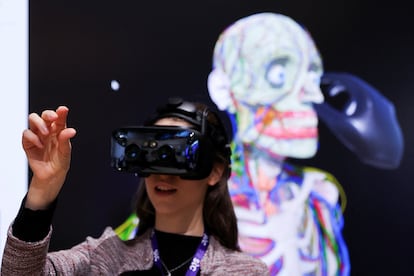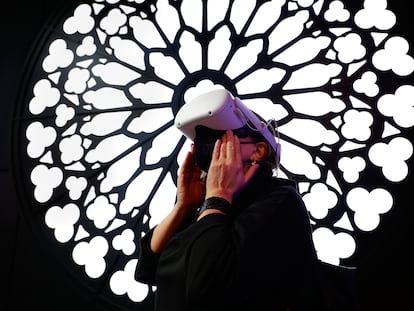Classes in the metaverse are now real
The immense potential of the digital environment in the field of education depends on it being in the right hands. The technology is also creating a new market for educators, schools, and businesses

A group of four people wanders aimlessly through the halls of the SIMO technology fair, the International Educational Technology and Innovation Exhibition held every year in Madrid. The group makes its way slowly, looking for someone who can give them a hand. They finally find someone. “We’ve come to see if you can help us. We want to introduce the students at our high school in Galicia to the metaverse. We already have the headsets, although we don’t know what to do with them. We have dozens of boxes with headsets like this one.” And they show their helper a brand new headset in its original packaging that they have been guarding like treasure.
This story, based on real events, is told by Francisco Roncero, who co-founded Educa360 in 2020. The promising new company devises immersive technological tools for the educational sector. In fact, the aforementioned virtual reality headsets are just one more instrument to immerse users in this new, parallel meta universe. The technology’s potential in the educational field can be immense, as long as its development, regulation, and promotion falls into the right hands.
To understand how all this can be done, the first thing is to be clear on the terminology. One thing is augmented reality (AR), which are applications that incorporate virtual elements into the real world, such as paintings from the Louvre on your living room wall. Another thing is virtual reality (VR), which takes us completely out of the real world through the use of VR headsets and allows us to have immersive experiences, particularly when playing a video game or visiting a museum. Although VR can also be accessed through other devices. But one step further is the metaverse, an entire parallel virtual universe, whose added value is the ability to carry out transactions using cryptocurrencies. And that is where you can create content aimed at education (from virtual classes, to masters degrees, and so on).
Where and how should we start? “By training teachers to use this content and be able to create it for their classes,” the expert in AI in education Juan Cigarrán responds. “If teachers combine the technology with the correct teaching methodology, a whole universe will open up for education.” With these words, Cigarrán, former university vice-president of Technology at the National Distance Education University (UNED) and lecturer at its School of Computer Science, conveys his optimism. “Another advantage is the accessibility it allows, both for people with mobility problems and students who live in isolated areas,” he points out.
The first experience users had in this field appeared with Second Life at the beginning of this century. The website that allowed you to live a parallel life through an avatar. Then the metaverse emerged actually as something complementary to the blockchain, which is a database where the registered information is validated in a decentralized way through a common protocol and that was created for the cryptocurrency market.
Adapting education to the virtual world
As a result, a whole range of multiverses, including one for education, can coexist in the metaverse. The possibilities are infinite. For example, to teach ballistic trajectory in physics, an archery simulation can be designed so that the students themselves can check the strength of the angle, explains Cigarrán. In turn, this creates a multidisciplinary universe that can allow the teacher to also become a 3D content designer for education or computer programs, creating new work opportunities in companies that create educational metaverses.
One such example is Educa360, the company that was mentioned at the beginning of this article. Francisco Roncero Lama and his business partner Fernando Sierra saw the opportunity to create a company that would provide technological elements to educators. “We take educational ideas and bring them closer to virtual concepts.” To do this, they have a permanent team of professionals from different fields, from programmers to virtual reality and 3D developers, infograph designers and documentary filmmakers to educators. And they also employ specialists in other fields (such as music) when they make products for those subjects.
The products are supervised and signed off by the Chair of Education and Emerging Technologies, Gamification, and Artificial Intelligence (EduEmer) at the Pablo de Olavide University. In collaboration with European Open Business School S.L., the chair promotes research, training, and distribution in everything related to education and technology.
“We create the beta version of the product so that the teacher or the education center can finish it,” explains Fran Roncero. That is, his company provides a program called EducaMaker to the center, and each teacher can make the changes they need to it for what they want to teach. But, in addition, the students themselves can also participate, thereby participating in directing their own learning.
The virtual environments created by the Educa360 team are not aimed at a specific educational level, and the idea is that they are not only to be used with the headset. While some students put on their headsets, others in the same class follow the task on a computer or other device. And some topics are not minor, such as versions of the Sistine Chapel with and without Michelangelo’s paintings (to be used in Art class) or a giant map of the world on which the student’s avatar walks and points out the capitals of each country (for Geography).
Educa360 also offers schools another metaverse service called Educaverse. This also allows them to have a space in the metaverse. “But Educaverse is limited. It is exclusive for educational initiatives. For example, some schools use it to make a digital copy of their premises so that future students and their parents can pay a virtual visit,” he adds.
But that’s not all. There are university and non-university centers that are creating their own currency to reward their students, who can use it for free tuition or course credits. Educa360 is finalizing an agreement with the Pablo de Olavide University to offer microcredentials that students can study within the University Degrees (for example, on aspects of the metaverse including the field’s legal issues, audiovisual production, 3D design, or marketing ) to become something like metaverse creators. That is to say, everything looks like it could be a future degree in itself in some universities, or perhaps part of a double degree.
Much to do
There are already various initiatives and a lot of ideas, but experts warn that resources and social impetus are needed. This is so that the changes and contributions of the metaverse to the educational world are applied widely and do not contribute to widening the gap between the centers and regions in which digital literacy is advancing at different speeds.
“Although its potential may be enormous, today, “it is still very much in its infancy,” says Alejandro Tiana, emeritus professor at UNED, former Secretary of State for Education in Spain, and author of the latest educational reform. “The educational processes that we were already familiar with could have an interesting educational orientation in the metaverse. It is a very wide world and, if used properly, it will allow education experts to trace student trajectories or create tasks in the metaverse that, having previously given the student the appropriate tools, allow them to detect the students’ individual weak spots.” It can also allow learning to be systematized more rigorously and make marking easier, adds Tiana. “The main problem,” this expert highlights, is that “it requires very strong prior input from teachers, because what has been done so far is still a bit rudimentary.”
In preparing the latest educational reform, Tiana’s team worked with the Data Protection Agency to include an article that established a first legislative basis. This is article 111a, which allows the use of information through a system of student identification codes: “An identification number will be regulated for each student, in order to make it easier to exchange relevant information and monitor the individualized educational trajectories, including the educational measures that may have been applied.”
An essential issue to address in this context is the initial training of future teachers, especially in the faculties of education. Currently, the members of the Conference of Deans of these faculties are debating reforming the course content.
María del Mar Sánchez Vera is a lecturer at the Faculty of Education at the University of Murcia and a member of its Educational Technology Research Group: “The metaverse is a field of study with little evidence. There is still little research behind it, although I’ve been talking about it since Second Life appeared. But the studies that have been done so far show, for example, that it favors motivation for learning,” she says.
“The metaverse allows learning to be personalized, since students move through it with their avatar and this is all very interesting, but what is more important is the task they have to do there,” Sánchez Vera stresses. “This represents a change in the role of the teacher, from source of information to task facilitator or guide.” Otherwise use of the metaverse in the classroom would fall into use merely as entertainment.
An issue that raises some suspicion among teachers and parents is that of safety. “Essential issues still need to be regulated, such as security,” the lecturer mentions, “we must know whose hands the metaverse is in right now, and what data we may be transferring from minors to large technology companies, for example,” she warns. Sánchez Vera teaches this topic to the students at her university. But it is only a one semester-long class in the four years of the degree in Education. “We have to teach everything from how to use technology in the classroom to the metaverse in that limited time. “This should be reformulated,” she suggests.
And, as a culmination, the metaverse can be extremely useful when it comes to finding out the student’s educational pathways, accrediting teachers, or managing their degrees, careers, or academic awards. If they are in the metaverse, there would be no need for a third party who has to approve anything, because what is in the metaverse has a legal status. “Today, technology sets the pace for the rest of the world,” Juan Cigarrán sums up. “And in the world of education we have to incorporate the metaverse now and get the most out of it.”
Of the more bizarre ideas, at least for today, is setting up a school or university entirely in the metaverse. However, none of these experts wants to stick their neck out and say this will not happen in the future. And it may not be so far away, especially if it starts to use artificial intelligence (AI).
Sign up for our weekly newsletter to get more English-language news coverage from EL PAÍS USA Edition
Tu suscripción se está usando en otro dispositivo
¿Quieres añadir otro usuario a tu suscripción?
Si continúas leyendo en este dispositivo, no se podrá leer en el otro.
FlechaTu suscripción se está usando en otro dispositivo y solo puedes acceder a EL PAÍS desde un dispositivo a la vez.
Si quieres compartir tu cuenta, cambia tu suscripción a la modalidad Premium, así podrás añadir otro usuario. Cada uno accederá con su propia cuenta de email, lo que os permitirá personalizar vuestra experiencia en EL PAÍS.
¿Tienes una suscripción de empresa? Accede aquí para contratar más cuentas.
En el caso de no saber quién está usando tu cuenta, te recomendamos cambiar tu contraseña aquí.
Si decides continuar compartiendo tu cuenta, este mensaje se mostrará en tu dispositivo y en el de la otra persona que está usando tu cuenta de forma indefinida, afectando a tu experiencia de lectura. Puedes consultar aquí los términos y condiciones de la suscripción digital.









































